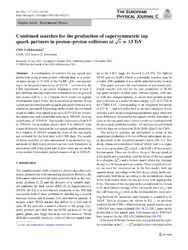Combined searches for the production of supersymmetric top quark partners in proton–proton collisions at √s = 13 TeV
| dc.contributor.author | Tumasyan, A. | |
| dc.contributor.author | Işıldak, Bora | |
| dc.date.accessioned | 2023-05-08T12:19:42Z | |
| dc.date.available | 2023-05-08T12:19:42Z | |
| dc.date.issued | 2021-11-03 | |
| dc.identifier.issn | 1434-6044 | en_US |
| dc.identifier.uri | http://hdl.handle.net/10679/8206 | |
| dc.identifier.uri | https://link.springer.com/article/10.1140/epjc/s10052-021-09721-5 | |
| dc.description.abstract | A combination of searches for top squark pair production using proton–proton collision data at a center-of-mass energy of 13Te at the CERN LHC, corresponding to an integrated luminosity of 137fb-1 collected by the CMS experiment, is presented. Signatures with at least 2 jets and large missing transverse momentum are categorized into events with 0, 1, or 2 leptons. New results for regions of parameter space where the kinematical properties of top squark pair production and top quark pair production are very similar are presented. Depending on the model, the combined result excludes a top squark mass up to 1325Ge for a massless neutralino, and a neutralino mass up to 700Ge for a top squark mass of 1150Ge. Top squarks with masses from 145 to 295Ge, for neutralino masses from 0 to 100Ge, with a mass difference between the top squark and the neutralino in a window of 30Ge around the mass of the top quark, are excluded for the first time with CMS data. The results of theses searches are also interpreted in an alternative signal model of dark matter production via a spin-0 mediator in association with a top quark pair. Upper limits are set on the cross section for mediator particle masses of up to 420Ge. | en_US |
| dc.description.sponsorship | BMBWF and FWF (Austria); FNRS and FWO (Belgium); CNPq, CAPES, FAPERJ, FAPERGS, and FAPESP (Brazil); MES (Bulgaria); CERN; CAS, MoST, and NSFC (China); MINCIENCIAS (Colombia); MSES and CSF (Croatia); RIF (Cyprus); SENESCYT (Ecuador); MoER, ERC PUT and ERDF (Estonia); Academy of Finland, MEC, and HIP (Finland); CEA and CNRS/IN2P3 (France); BMBF, DFG, and HGF (Germany); GSRT (Greece); NKFIA (Hungary); DAE and DST (India); IPM (Iran); SFI (Ireland); INFN (Italy); MSIP and NRF (Republic of Korea); MES (Latvia); LAS (Lithuania); MOE and UM (Malaysia); BUAP, CINVESTAV, CONACYT, LNS, SEP, and UASLPFAI (Mexico); MOS (Montenegro); MBIE (New Zealand); PAEC (Pakistan); MSHE and NSC (Poland); FCT (Portugal); JINR (Dubna); MON, RosAtom, RAS, RFBR, and NRC KI (Russia); MESTD (Serbia); SEIDI, CPAN, PCTI, and FEDER (Spain); MOSTR (Sri Lanka); Swiss Funding Agencies (Switzerland); MST (Taipei); ThEPCenter, IPST, STAR, and NSTDA (Thailand); TUBITAK and TAEK (Turkey); NASU (Ukraine); STFC (United Kingdom); DOE and NSF (USA). Individuals have received support from the Marie-Curie program and the European Research Council and Horizon 2020 Grant, contract Nos. 675440, 724704, 752730, 758316, 765710, 824093, and COST Action CA16108 (European Union); the Leventis Foundation; the Alfred P. Sloan Foundation; the Alexander von Humboldt Foundation; the Belgian Federal Science Policy Office; the Fonds pour la Formation a la Recherche dans l'Industrie et dans l'Agriculture (FRIA-Belgium); the Agentschap voor Innovatie doorWetenschap en Technologie (IWTBelgium); the F.R.S.-FNRS and FWO (Belgium) under the "Excellence of Science -EOS" -be.h project n. 30820817; the Beijing Municipal Science& Technology Commission, No. Z191100007219010; theMin-istry of Education, Youth and Sports (MEYS) of the Czech Republic; theDeutsche Forschungsgemeinschaft (DFG), underGermany's Excellence Strategy -EXC 2121 "Quantum Universe" -390833306, and under project number 400140256 -GRK2497; the Lendulet ("Momentum") Program and the Janos Bolyai Research Scholarship of the Hungarian Academy of Sciences, the New National Excellence Program UNKP, the NKFIA research grants 123842, 123959, 124845, 124850, 125105, 128713, 128786, and 129058 (Hungary); the Council of Science and Industrial Research, India; the Latvian Council of Science; the Ministry of Science and Higher Education and the National Science Center, contracts Opus 2014/15/B/ST2/03998 and 2015/19/B/ST2/02861 (Poland); the National Priorities Research Program by Qatar National Research Fund; the Ministry of Science and Higher Education, project no. 0723-2020-0041 (Russia); the Programa Estatal de Fomento de la Investigacion Cientifica y Tecnica de Excelencia Maria de Maeztu, grant MDM-2015-0509 and the Programa Severo Ochoa del Principado de Asturias; the Stavros Niarchos Foundation (Greece); the Rachadapisek Sompot Fund for Postdoctoral Fellowship, Chulalongkorn University and the Chulalongkorn Academic into Its 2nd Century Project Advancement Project (Thailand); the Kavli Foundation; the Nvidia Corporation; the SuperMicro Corporation; the Welch Foundation, contract C-1845; and the Weston Havens Foundation (USA). | |
| dc.language.iso | eng | en_US |
| dc.publisher | Springer | en_US |
| dc.rights | openAccess | |
| dc.rights.uri | https://creativecommons.org/licenses/by/4.0/ | |
| dc.title | Combined searches for the production of supersymmetric top quark partners in proton–proton collisions at √s = 13 TeV | en_US |
| dc.type | Article | en_US |
| dc.description.version | Publisher version | en_US |
| dc.peerreviewed | yes | en_US |
| dc.publicationstatus | Published | en_US |
| dc.contributor.department | Özyeğin University | |
| dc.contributor.authorID | (ORCID 0000-0002-0283-5234 & YÖK ID 124605) Işıldak, Bora | |
| dc.creator | The CMS Collaboration | |
| dc.identifier.volume | 81 | en_US |
| dc.identifier.issue | 11 | en_US |
| dc.identifier.wos | WOS:000714374500001 | |
| dc.identifier.doi | 10.1140/epjc/s10052-021-09721-5 | en_US |
| dc.identifier.scopus | SCOPUS:2-s2.0-85118797403 | |
| dc.relation.publicationcategory | Article - International Refereed Journal - Institutional Academic Staff |
Files in this item
This item appears in the following Collection(s)
Share this page




